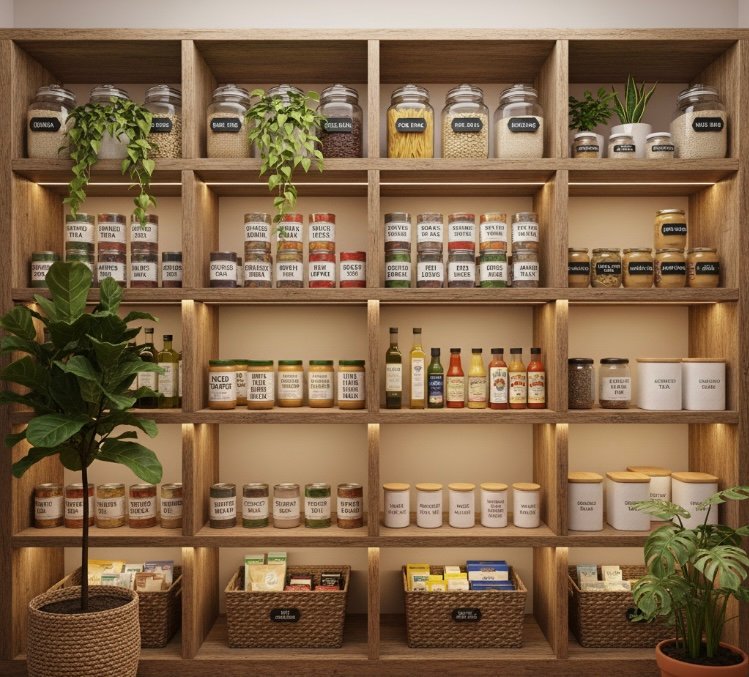The Emergency Back-up Pantry – What Does Yours Look Like?

What does your pantry look like? Do you have one? I don’t think you need to ask why you need one.
A backup pantry isn’t a bunker or a hoard of beans. It’s a sensible stash of food and supplies that helps you handle storms, power outages, supply chain hiccups, or just busy weeks when you don’t get to the store.
A backup pantry is resilience you can eat.
What Is a Backup Pantry
Think of it as a second layer of groceries. Your main pantry or fridge holds what you’ll eat this week. Your backup pantry quietly waits in the background, full of shelf-stable foods and supplies with longer best-before dates.
It’s not about panic-buying. It’s about being prepared without waste.
A backup emergency pantry should provide at least two weeks of food per person, with most authorities recommending a minimum of three days but advising that two weeks is much more practical for a real emergency. This duration prepares for common disruptions like storms, power outages, or infrastructure blockages where resupply is delayed and access to stores is cut off.
What to Buy
Variety is the key to nutritional completeness.
Start with what your household actually eats, then build outward. Focus on shelf-stable items, long-lasting produce, and basic supplies.
- Grains and starches: rice, oats, pasta, flour, potatoes
- Proteins: canned fish, beans, lentils, peanut butter, powdered eggs
- Vegetables and fruit: canned tomatoes, dried fruit
- Dairy substitutes: shelf-stable milk or plant-based cartons
- Cooking basics: oils, vinegar, sugar, salt, spices
- Comfort foods: tea, coffee, chocolate, crackers
- Extras: soup bases, bouillon cubes, baking mixes, condiments
- Powdered eggs, powdered milk
Recommended Duration and Rationale
Minimum:
3 days per person (bare minimum for short-term emergencies).
Practical Goal:
2 weeks per person (covers most disaster scenarios and is strongly suggested by preparedness experts).
Extended Coverage:
A 30-day period per person is excellent for serious disruptions and for those seeking greater preparedness.
Supplies Per Person
Calories:
1,500–2,000 calories per day per adult is the basic subsistence guideline.
Water:
One gallon (about 4 liters) per day per person for drinking and hygiene.
Food Groups:
Variety is the key to nutritional completeness.
Include grains (rice, pasta, oats), protein sources (canned fish, beans, lentils, nut butters, powdered eggs), vegetables and fruits (canned, dried, shelf-stable), dairy substitutes, cooking basics, comfort foods, and extras such as condiments and soup bases.
Typical Two-Week Pantry Amounts
For a single person for 14 days:
• 14 cans of protein (meat/fish/beans)
• 14 cans of vegetables
• 14 cans of fruit
• 14 servings cereal/grains
• 14 servings of milk (canned or shelf-stable)
How to Stock and Rotate
The golden rule: buy what you eat and eat what you buy.
- Use the first-in, first-out method. When you buy a new can of beans, put it behind the old one.
- Plan meals from your stash. Canned tomatoes in the pantry? Make chili this week.
- Do a quick check once a month. Move older items to the front.
- Keep a running list taped inside the cupboard so you don’t double-buy or forget what’s there.
Storage Solutions for Small Spaces
Not everyone has a basement or walk-in pantry. In apartments or smaller homes, creativity makes all the difference.
- Under the bed: slim bins hold pasta, rice, or canned goods.
- Closet corners: stackable bins fit behind shoes or coats.
- Vertical storage: add a narrow rolling cart beside the fridge or washer.
- Decorative storage: put flour, oats, or snacks in glass jars on open shelves—they look good and free up cupboard space.
- Freezer hacks: if your freezer is small, dedicate one basket to “backup” foods so they don’t get lost.
Backup Pantry Categories Table
Here’s a simple way to think about what to keep on hand:
| Category | Examples | Notes on Storage and Rotation |
| Grains and Starches | Rice, pasta, oats, flour, crackers | Store in airtight containers to prevent pests |
| Proteins | Canned tuna, beans, lentils, peanut butter, powdered eggs | Rotate often, check for dents on cans |
| Vegetables and Fruit | Canned tomatoes, corn, dried fruit, apples, frozen vegetables | Choose no-salt or low-sugar options |
| Dairy and Substitutes | Shelf-stable milk, plant-based cartons, powdered milk | Mark open cartons with date |
| Cooking Basics | Oils, vinegar, sugar, salt, spices | Keep oils in a cool, dark spot |
| Comfort Foods | Coffee, tea, chocolate, cookies | Boosts morale during stressful times |
| Extras and Condiments | Bouillon cubes, baking mixes, sauces | Rotate regularly, buy in small amounts |
A backup pantry is less about stockpiling and more about peace of mind
You don’t need to build it overnight. Add a few extra items each time you grocery shop, rotate what you have, and store them in ways that work for your space.
It’s not wasted effort. It’s resilience you can eat, with a side of comfort food for the tougher days.
